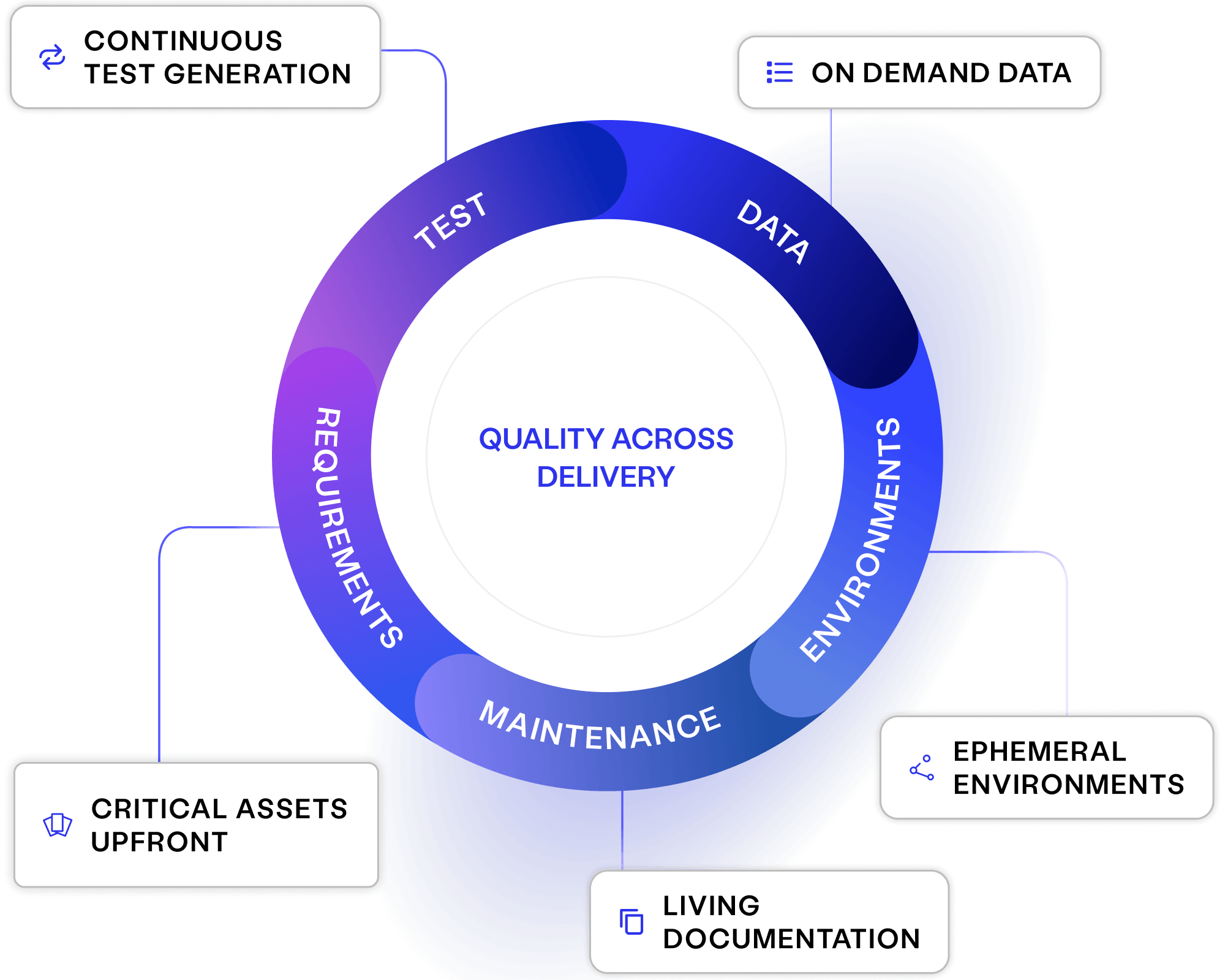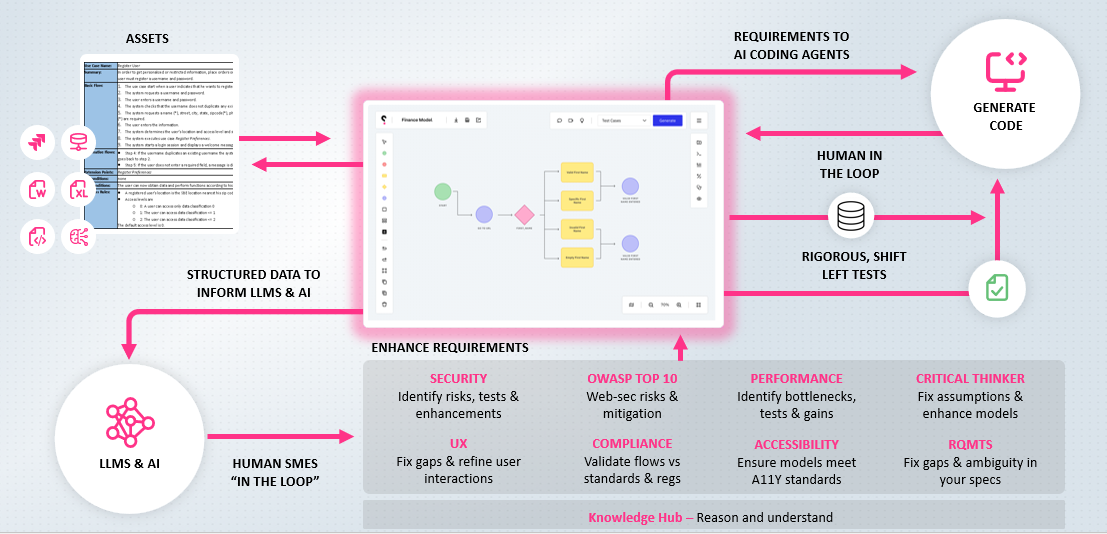Curiosity has pioneered a new approach to diagnose and address challenges within enterprise software delivery, dividing the process into inner and outer loops. The inner loop targets developer's tasks, while the outer loop encompasses all the supporting activities, including requirements, testing, environments, and data management.
 Curiosity Software have pioneered the first ever platform for the Outer Loop of software delivery.
Curiosity Software have pioneered the first ever platform for the Outer Loop of software delivery. The outer loop presents several challenges that impede the efficiency and effectiveness of the software development lifecycle. Fragmented processes and disconnected activities create bottlenecks and reduce productivity. Lack of transparency and poor communication among stakeholders lead to misunderstandings and misaligned goals, affecting product quality. Additionally, data silos complicate gaining a comprehensive project view, hindering decision-making and progress tracking. Maintaining consistent quality is a huge challenge without integrated tools and processes that align with quality goals.
To address these outer loop challenges, Curiosity developed Quality Modeller. This solution directly addresses outer loop challenges by integrating quality throughout the software development lifecycle, tackling bottlenecks in requirements, development, testing, and maintenance, aligning all stakeholders on quality goals and providing transparency and measurable quality.
AI and Its Impact on Software Delivery
AI's potential in revolutionising software delivery is immense. By leveraging AI, we can significantly improve efficiency, accuracy, and collaboration across the development lifecycle. Modelling will be a key component to drive AI based advancements across software delivery. Why is modelling a necessity to unlock the value of AI in software delivery?
- Structured Data Necessity: AI demands structured data, which is often lacking in our domain. Models, being inherently structured, serve as an invaluable data source, providing the necessary foundation for AI processes.
- Building Trust: Trust is a critical component of AI adoption. Models offer the capability to immediately visualise and understand the results produced by AI, fostering trust among stakeholders.
- Human-In-The-Loop: Effective collaboration and communication are crucial to aligning business needs with software requirements for AI consumption. Models have proven to be fantastic communication assets, facilitating a human-in-the-loop approach to AI processes operated by agents.
Visual Modelling and AI Integration
Quality Modeller AI combines modelling and AI to accelerate product releases, and enhance software quality, driving significant business value. The solution is centred around three key areas Knowledge Capture, SME Augmentation, and Exporters.
Knowledge Capture - model builders encompass tools and processes designed to create and refine models. This includes code scanners, requirements scanners, application scanners, and the analysis of meeting transcriptions. These tools provide a structured foundation for AI processes, enabling efficient and accurate data integration throughout the development lifecycle.
SME Augmentation - enhance models with expert knowledge. This involves features such as auto-complete, subflow expansion, and intelligent agents (Intelli-Agents) that assist in modelling tasks. Additionally, an AI Co-Pilot provides intelligent suggestions and guidance during the modelling process. This human-in-the-loop approach ensures that AI processes are aligned with business needs and stakeholder expectations.
Exporters - automate the use of models in various outputs, facilitating the generation of product requirements documents, code snippets, and application code. By automating these outputs, we streamline the software development process, ensuring consistency and reducing manual effort.
Our workflow places modelling at the centre of software delivery, integrating these three areas seamlessly into the development lifecycle. This holistic approach ensures that quality is embedded throughout the process, from initial requirements gathering to final product delivery, driving efficiency, transparency, and measurable quality improvements.

Quality Modeller AI - Capabilities
Our current capabilities reflect the integration of advanced modelling and AI that streamline and enhance aspects of software delivery.
Knowledge Capture
Requirements Import - The requirements importer streamlines the process of capturing models from large requirements documents. This automation saves a significant amount of time by eliminating the need to build models from scratch, allowing teams to quickly verify requirements and collaborate more effectively. With a structured model in place, teams can immediately move into validation, and early testing (shift left) to ensure that all requirements are accurately captured, understood, and are complete.
Meeting Import - The meeting import feature analyses meeting discussions to extract relevant information to capture knowledge of systems and business processes. This information is then integrated into the models to capture core knowledge for later access to reduce technical debt and preserve knowledge.
Code Import - Code import allows for the scanning and modeling of existing codebases, providing a clear and organised view of the current state of the code. This feature helps in increasing understanding of core use cases embedded in code. Additionally, it significantly reduces onboarding time by offering new team members a structured and detailed insight into existing processes, facilitating quicker integration and alignment with ongoing projects.
AI Powered Model Designer - A dynamic question-and-answer framework designed to build visual models by tapping into the expertise of subject matter experts (SMEs), ensuring accuracy, capturing critical knowledge that might otherwise be overlooked, reducing development time, and enhancing collaboration across teams.
SME Augmentation
Auto-complete - Auto-complete functionality enhances productivity by providing intelligent suggestions during the modelling process. This feature reduces the effort required to complete models through intelligent, context-aware suggestions.
Model expand - automatically generate detailed sub-components based on existing models. This capability ensures comprehensive coverage of all scenarios and reduces the risk of missing critical steps. By providing a clearer and more complete view, teams can better understand the intricacies of a requirement.
Intelli-Agents - Intelli-Agents are intelligent virtual subject matter experts (SMEs) that augment the modelling process with specialized knowledge in areas such as accessibility, performance, and security. These agents assist with various modelling tasks by providing real-time insights and recommendations, helping to identify potential issues and offering suggestions for improvement. This support enables teams to integrate expert knowledge seamlessly into their workflows.
Co-Pilot - The AI Co-Pilot offers context-aware suggestions and guidance during modelling. This feature helps in identifying best practices, avoiding common pitfalls, and accelerating the modelling process. The Co-Pilot acts as a valuable assistant, enhancing the capabilities and ensuring higher quality models.
Exporters
Product Requirements Generation - The product requirements generation feature automates the creation of comprehensive product requirements documents from the models. By using the structured data, it ensures that all requirements are accurately captured and clearly presented. This automation saves time, reduces errors, and improves the quality of documentation, making it easier for teams to align on project goals.
Code Snippet Generation - Code snippet generation automatically produces code snippets based on the models, speeding up the development process. Developers can quickly implement functionality aligned with the project’s requirements, enhancing productivity and ensuring quality.
Vision to Revolutionise Software Delivery
Our vision is to fundamentally transform the way enterprises approach software delivery, by making modelling the cornerstone of this evolution. We believe that by embedding quality, automation, and AI-driven insights throughout the entire software development lifecycle, we can eliminate inefficiencies, improve collaboration, and elevate product quality to unprecedented levels.
Our future direction is focused on expanding the capabilities of Quality Modeller AI to not only streamline existing processes but to anticipate and address the needs of tomorrow's enterprises. We aim to create a seamless, end-to-end system where models serve as the central source of truth, enabling teams to innovate faster, align more closely on objectives, and maintain the highest standards of quality throughout every stage of software delivery.